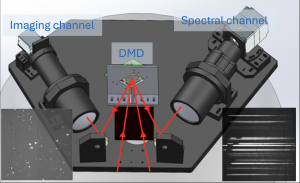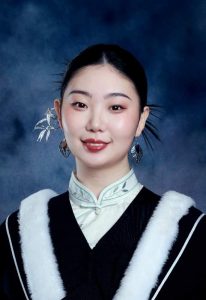Emma was born and raised in Beijing, China, and moved to Montreal with family at the age of 15. In June 2025, Emma finished studies at UofT as an undergraduate student with a specialist in Astronomy and Physics. Emma will continue to study at UofT for a MSc degree in Physics. Besides schoolwork, Emma loves acrylic painting and doing hand crafts. Emma enjoys going to work out after SURP and used to be a national second–level athlete in free-style swimming.
What made you decide to participate in SURP?
I gained great experience in AST425 and AST431. Since I will continue my masters study at UofT, I would like to take this opportunity as a smooth transition. I would like to have more instrumental research experience which is what I planned for my masters study, and aligned with my future career plan.
Can you tell us about your research project?
My research project is called “DMD-MOS calibration and On-Sky Testing” (Digital Micro-mirror Device-based Multi-Object Spectrograph). It is a new generation of spectrograph that allows for instantaneous slit mask configuration. Each micro-mirror is able to tilt to two opposite angles so that the light path can be split into either an imaging or spectroscopy channel. Since it can produce multiple slits, we can obtain the spectrum of multiple astronomical objects simultaneously. Compared with older spectrographs, we don’t have to finely adjust the telescope and the slit reconfiguration is instantaneous, which saves on-sky time.
What is your favourite thing about SURP?
I would say beside our great team and great supervisors, my favourite thing is the weekly seminars. It covers many aspects for example: the astronomy frontiers, different astronomy branches, mental health workshop, reading/writing/presentation workshops, etc. I really enjoys these talks and learned a lot from them.
Can you explain how SURP has been different from your undergrad work?
Compared with research courses like AST425 and AST431, SURP is a full-time job. Which means I am able to spend much more time onto one single project. And at the same time, there is no pressure from other courses or gradings. I can have a better focus while making more great progress in the project.
What are your plans for the future?
A short term plan for me is to successfully complete my masters degree with a prof who’s doing telescope/instrumentation relate to astronomy. A longer plan is to apply for PhD and continue my journey in astronomical studies.

A diagram of the Digital Micro-mirror Device-based Multi-Object Spectrograph, or DMD-MOS, that Emma is working on this summer.
The Dunlap Institute for Astronomy and Astrophysics at the University of Toronto is an endowed research institute with over 80 faculty, postdocs, students, and staff, dedicated to innovative technology, ground-breaking research, world-class training, and public engagement.
The research themes of its faculty and Dunlap Fellows span the Universe and include: optical, infrared and radio instrumentation, Dark Energy, large-scale structure, the Cosmic Microwave Background, the interstellar medium, galaxy evolution, cosmic magnetism, and time-domain science.
The Dunlap Institute, the David A. Dunlap of Astronomy and Astrophysics, and other researchers across the University of Toronto’s three campuses together comprise the leading concentration of astronomers in Canada, at the leading research university in the country.
The Dunlap Institute is committed to making its science, training, and public outreach activities productive and enjoyable for everyone of all backgrounds and identities.


